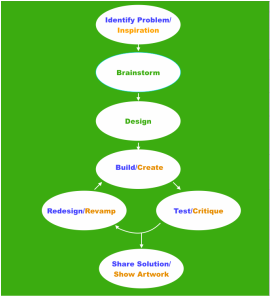
Objective: Design a kinetic sculpture, using recycled plastic, that is powered by wind.
Materials: paint pens, clean plastic bottles and tops of all sizes (small water bottles, 1 liter, 2 liter, and 3 liter bottles), newsprint, scissors, wooden dowels, recycled plastic containers of all sizes, pony beads (big enough to go over the wooden dowel), sharp blades and or drill.
Prep: Drill or cut a hole in the tops of the recycled bottles so the wooden dowel can go though it. I let a responsible student do this using proper safety glasses.
Explain the engineering process
Identify Problem->Brainstorm->Design->Test and Evaluate->
Redesign-> Test and Evaluate-> Share Solution
What is kinetic sculpture? Show examples of these hypnotic wind-powered kinetic sculptures by Anthony Howe
Discuss how and why objects move in the wind.
Identify the problem:
What is kinetic sculpture? Discuss how and why objects move in the wind.
Discuss how wind makes wind turbines move? Carefully look at the design.
Keywords and links-
Bernoullis Principle. Here is a great demonstration by a teacher on Youtube explaining Bernoullis Principle which deals with air pressure.
Aerodynamics
Brainstorm:
Have the kids work in groups to brainstorm blade designs (shape, length, width, number of blades, etc.) for their kinetic sculpture. Sketch out ideas on newsprint. Decide which designs may work best.
Design:
Give them bottles and dowels, and scissors to cut into designs that may catch the wind.
Once they find some designs that work, students can decorate bottles (better to do this before they cut into them) using brightly colored paint pens.
Cut the bottles into the wind catching designs and thread onto a dowel. Use a colorful pony bead to secure bottles on the dowel.
If you use multiple bottles make sure you leave enough room between them so they do not interfere with each other.
Test:
Along the way, test and tweak designs using a fan.
Share:
You can display sculptures in an open space and watch them move and spin in the wind!
Extensions:
Science: How is wind created?
Renewable Energy- Wind
Social Issues of Wind Power
Environmental Issues
Health Hazards
Standards
Art: NJCCCS
Science: Next Generation Standards: 5.1.8.B:1, 5.1.8.B.2, 5.1.8.C.1, 5.1.8.c.2, 5.1.8.D.1, 5.1.8.D.2
Materials: paint pens, clean plastic bottles and tops of all sizes (small water bottles, 1 liter, 2 liter, and 3 liter bottles), newsprint, scissors, wooden dowels, recycled plastic containers of all sizes, pony beads (big enough to go over the wooden dowel), sharp blades and or drill.
Prep: Drill or cut a hole in the tops of the recycled bottles so the wooden dowel can go though it. I let a responsible student do this using proper safety glasses.
Explain the engineering process
Identify Problem->Brainstorm->Design->Test and Evaluate->
Redesign-> Test and Evaluate-> Share Solution
What is kinetic sculpture? Show examples of these hypnotic wind-powered kinetic sculptures by Anthony Howe
Discuss how and why objects move in the wind.
Identify the problem:
What is kinetic sculpture? Discuss how and why objects move in the wind.
Discuss how wind makes wind turbines move? Carefully look at the design.
Keywords and links-
Bernoullis Principle. Here is a great demonstration by a teacher on Youtube explaining Bernoullis Principle which deals with air pressure.
Aerodynamics
Brainstorm:
Have the kids work in groups to brainstorm blade designs (shape, length, width, number of blades, etc.) for their kinetic sculpture. Sketch out ideas on newsprint. Decide which designs may work best.
Design:
Give them bottles and dowels, and scissors to cut into designs that may catch the wind.
Once they find some designs that work, students can decorate bottles (better to do this before they cut into them) using brightly colored paint pens.
Cut the bottles into the wind catching designs and thread onto a dowel. Use a colorful pony bead to secure bottles on the dowel.
If you use multiple bottles make sure you leave enough room between them so they do not interfere with each other.
Test:
Along the way, test and tweak designs using a fan.
Share:
You can display sculptures in an open space and watch them move and spin in the wind!
Extensions:
Science: How is wind created?
Renewable Energy- Wind
Social Issues of Wind Power
Environmental Issues
Health Hazards
Standards
Art: NJCCCS
Science: Next Generation Standards: 5.1.8.B:1, 5.1.8.B.2, 5.1.8.C.1, 5.1.8.c.2, 5.1.8.D.1, 5.1.8.D.2
